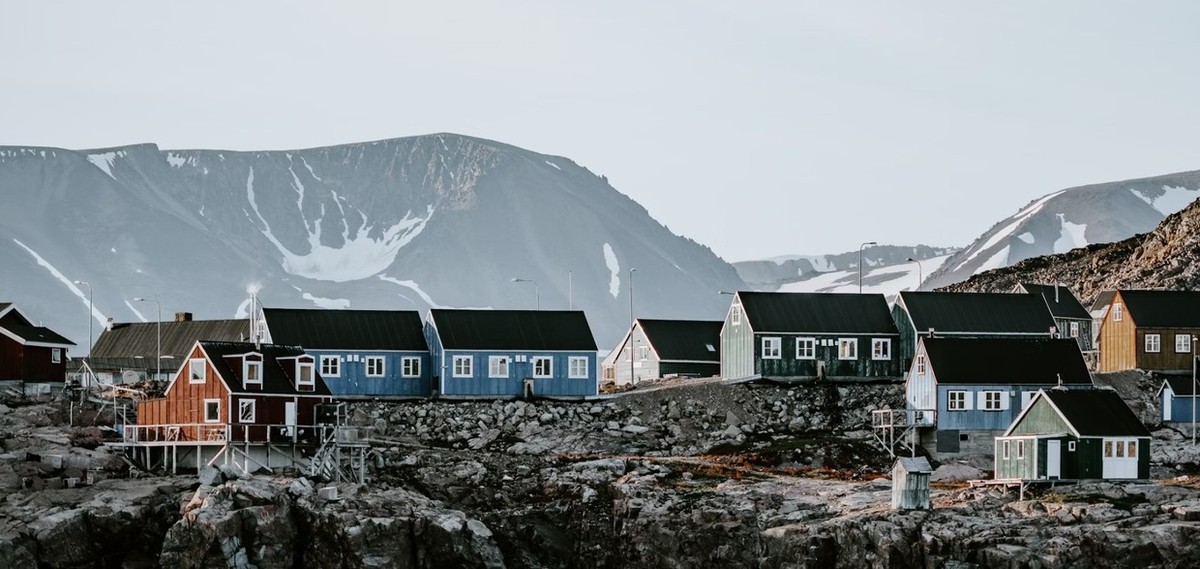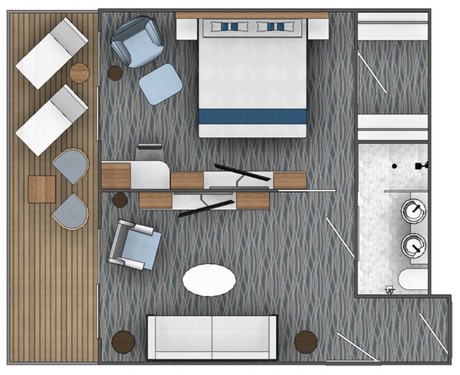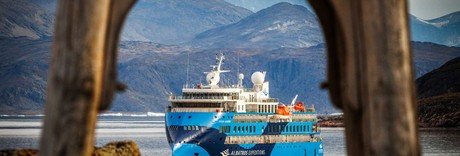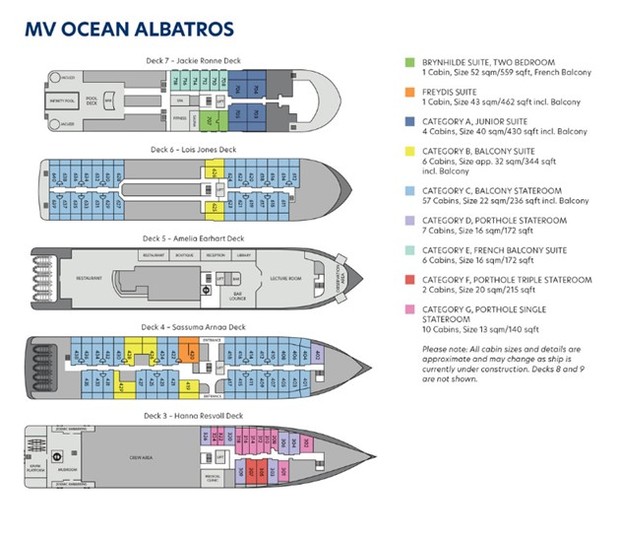
Voyage to one of the wildest and remote regions in the world, the breathtaking coasts of East Greenland. Experience the region's beauty and diversity on this unique voyage combining the best of East Greenland.
Wild. Rugged. Remote. Pristine. Words which describe, but fail to capture the majesty of one of the wildest regions on planet Earth.
The flickering aurora borealis, vast glaciers, precipitous mountains and charismatic Arctic wildlife are just some of the spectacles we hope to see on the wild shores of Earth's largest island. Experience Tunumiit culture and incredible history in Ammassalik region, meet the locals in Greenland's most isolated community in Scoresbysund, and experience the unrivalled majesty of the Northeast Greenland National Park - the largest in the world.
Beginning from the Icelandic capital of Reykjavík, this unique itinerary combines three regions of East Greenland into one thrilling voyage. Crossing the Denmark Strait, we arrive in Ammassalik region, where we will visit the city of Tasiilaq, capital of East Greenlandic culture and tradition, before exploring the historical sites, villages and staggering natural beauty of the region. From Ammassalik, we will head to the settlement of Ittoqqortoormiit in the vast fjord sysem of Scoresbysund, where visitors can experience the unique traditions and customs of the Inuit pioneers who made this region their home.
Leaving Scoresbysund behind, we will set a course for the North East Greenland National Park. This is the largest protected area of land on Earth, and holds no permanent residents, save wildlife such as the muskoxen grazing on the tundra and the beluga frolicking in the icy fjords. Surrounded by breathtaking scenery, we will come ashore at remote landing sites, explore vast glaciers on our fleet of Zodiacs, and if we're lucky, experience the majesty of the northern lights in pristine wilderness.
Blending Inuit culture, mind-boggling natural beauty and the chance to see some of the Arctic's most charismatic wildlife, this voyage showcases the best of the Arctic's largest wilderness.
- Immerse in East Greenland's Rich Culture: Explore the vibrant city of Tasiilaq in the Ammassalik region, delving into the heart of East Greenlandic culture and tradition.
- Encounter Arctic Pioneers in Scoresbysund: Visit the isolated settlement of Ittoqqortoormiit, nestled in the vast fjord system of Scoresbysund, where you can connect with the unique traditions of the Inuit pioneers.
- Discover the Majesty of North East Greenland National Park: Sail to the world's largest protected area, the North East Greenland National Park, witnessing pristine wilderness, vast glaciers, and Arctic wildlife, including muskoxen and beluga whales.
Prices quoted here are often dependent on currency fluctuations. Please check with (01432 507450 or info@small-cruise-ships.com) for the very latest price, which may well be cheaper than the one advertised here.









The rock-like columns of Hallgrímskirkja Church loom over the city of Reykjavík, a hip Scandi capital which needs little introduction. With new Nordic cuisine, excellent shopping, fantastic excursions and an easy relaxed vibe, Reykjavík is one of Scandinavia's most welcoming and exciting cities.
In the afternoon, we await to welcome our guests onboard Ocean Albatros. After our mandatory safety drill, enjoy dinner and a glass of champagne as we set sail a course for adventure as we set out across the Denmark Strait, bound for Greenland.
The Denmark Strait is the narrow section of the North Atlantic separating Iceland from Greenland. This body of water is among the most productive in the world, where the cold polar East Greenland Current collides with the warm northbound Gulf Stream. These nutrient-rich waters support vast stocks of fish, and the humans, seals, whales and seabirds which rely on them.
Days at sea are never dull. We will arrange a variety of activities onboard for our guests to enjoy to engage the mind, body and soul. Join your knowledgeable Expedition Team lecturers in the Theatre to hear specially-crafted lectures on Greenlandic history, wildlife, geology, culture and more, unwind with a massage in the Albatros Polar Spa, or simply watch the seabirds gliding along the ship from our hot tubs as the Ocean Albatros flies across the Denmark Strait.
We will spend the morning in the small village of Kuummiut, which sits in breathtaking surroundings in the calm reaches of Ammassalik Fjord. Kuummiut - meaning 'People who Live by the River' - is one of the larger villages in the area, and one of the most prosperous. Sitting upon some of East Greenland's richest fishing grounds, Kuummiut holds the only fish factory in the region, and fishermen from miles around come through Ammassalik Fjord (which is wide enough to stay mostly ice-free year-round) to sell their catch here.
Kuummiut is an ideal place to experience life in an East Greenlandic settlement. Where other towns have traffic, Kuummiut has the yowling of sled dogs and the sigh of the wind through the grass. No roads lead in or out of this isolated village, and the sea is the highway for local transport - although motorboats have replaced the skin boats which brought people to these shores long ago. It is a perfect place to simply sit, watch the icebergs pass, and perhaps see the whales which often frolic in the calm waters offshore.
In the afternoon, we will sail slightly eastward from Kuummiut to Ikateq, a spectacular fjord with a fascinating history. During the darkest days of the Second World War, American forces established an airbase here (one of the network of air bases which includes Kangerlussuaq on the west coast) to serve as a stepping stone for aircraft transiting between Europe and North America. The rugged landscape of East Greenland meant the approach into the airport was hazardous, with frequent fog masking the treacherous mountains. Huge recources were invested into Ikateq Airbase (also known as Bluie 2 East), with a 5,000ft runway, hangar, barracks and port constructed. A fleet of military vehicles and thousands of barrels of fuel were also brought to this remote region. With Germany defeated, improvements to intercontinental aircraft, and increasing tensions with the Soviet Union, the United States Military abandoned the base in 1947, leaving almost everything behind.
The air base has been a bone of contention between Nuuk, Copenhagen and Washington for many years. Many in the Greenlandic government wanted the site cleaned up and the ruins removed; an expensive and logistically challenging task. Eventually, the Danish Government agreed to remove hazardous waste from the site (mainly decaying fuel drums), leaving the rest of the equipment in place as an important part of regional history. Over 75 years later however, almost everything remains as it was on the day the Americans left. Ikateq is a truly unique place, a time warp to the Second World War: eerie, fascinating and surrounded by staggering natural beauty.
In the morning we arrive in Tasiilaq, the largest settlement in East Greenland. Unlike the west coast, which has had uninterrupted contact with Europe since the 1700s, the coast of East Greenland remained more or less uncontacted until around 1894, when a Danish trading post was established at Tasiilaq. The vast distances involved in Arctic travel meant that the people of East Greenland (Tunumiit) were isolated from their cousins to the west, and the language, traditions and culture of East Greenland therefore differ significantly to those in other parts of the country.
Ancient traditions are strong here. This region of Greenland was the home of the last Angakkuit (Shamans) of Greenland, and is the home of the tupilak - a monster fashioned from animal (and sometimes human) body parts and animated by the power of an Angakkuq to wreak havoc on enemies. Creating such a monster was dangerous, as it could be turned back by a more powerful magic user to attack its creator. The first Europeans were curious as to what these dark beasts looked like, and locals carved facsimiles in bone or horn, beginning one of Greenland's finest artistic traditions. The tupilaat made by artisans in Tasiilaq are considered among the best in the country.
Tasiilaq sits in a perfect natural harbour on Ammassalik Island (meaning 'the Place of Many Capelin'). While superficially similar to towns on the West Coast, visitors will quickly notice differences; the landscape here is much more rugged, the people fewer, and the sled dogs much more numerous. Tasiilaq offers excellent opportunities to explore, with excellent hiking routes such as the Flower Valley easily accessible from town. For those wishing to delve into Tunumiit culture, visit the museum, located in the city's old church, hear the city's exquisite choir perform in the modern church, or watch a drum dancer in traditional East Greenlandic costume perform a millennia-old spiritual tradition. For those wishing to indulge in some retail therapy, visit the Stunk Artist's Workshop, where skilled craftsmen create beautiful pieces from natural local materials.
Sailing along the coastline of this vast island (where reaching the next-closest town takes two nights and a day of sailing), it can be difficult to comprehend the scale of this huge country.
Measuring roughly four times the size of France, Greenland dominates the Atlantic portion of the Arctic, covering latitudes from 59-83°N, and 11-74°W. Around 80% of Greenland is covered by the Greenland Ice Sheet (known as Sermersuaq or 'The Great Ice' in Greenlandic), the largest body of ice on earth outside Antarctica. The Greenland Ice Sheet is so vast that it governs the weather patterns of the region, with summer meltwater and winter ice largely driving ocean currents in this part of the North Atlantic.
Despite the lack of towns, the stretch of coastline between the Ammassalik and Scorsesbysund region is of vital importance to the residents of the area. During the summer, locals hunt whales, seals and other game by boat along the coast of this vast wilderness, as their ancestors have done since time immemorial. Some skilled hunters still choose to use kayaks to sneak up on skittish prey like narwhals - continuing a millennia-old hunting tradition. While some choose to use snowmobiles in winter to traverse the sea ice which hugs the coast, most hunters choose to use dogsleds, which are more reliable, rugged, and do not rely on fuel. In this challenging country, ancestral traditions are still superior to the trappings of modern life.
Entering Scoresbysund, Earth's largest and longest fjord system, one could be forgiven for not realising this huge 35km inlet is a fjord at all! Scoresbysund is named for English whaler and explorer William Scoresby, one of the first Europeans to map this region; the local name for this vast fjord system, Kangertittivaq, is a typical Greenlandic understatement, roughly meaning 'The Rather Large Fjord'.
The only settlement in this region is Ittoqqortoormiit (meaning 'the People who Live in Big Houses), which surely ranks among the most remote communities on Earth. As the name suggests, the town is relatively new, having been established by Danish authorities in 1925. Colonists were relocated from the Ammassalik region further south in response to what were seen as poor living conditions in the area, as well to establish Danish sovereignty in the region during a territorial dispute with Norway. While the establishment of the town was challenging, the settlers soon realised the region was hugely rich in game, with excellent hunting and trapping opportunities. This tradition continues to this day - the majority of residents continue to live a subsistence hunting lifestyle, essential in a town where supply ships arrive only once or twice each summer. The only access to the outside world is via the heliport to the nearby airport, from where small aircraft depart for Iceland.
Ittoqqortoormiit is a town with a strong sense of community and traditional culture, where foreigners are welcomed warmly. The town hosts an excellent museum, a beautiful traditional Greenlandic church, and locals often welcome visitors to their community wearing colourful traditional costumes. The town represents a wonderful introduction to the culture and lifestyle of Northeast Greenland, in one of the most spectacular natural locations anywhere in the world.
During the night we cruise past the rugged peaks of the Liverpool Land peninsula and reach the mouth of King Oscar Fjord. We are now in the vast Northeast Greenland National Park; measuring almost a million square kilometers (almost twice the size of France), this is the largest National Park and the largest area of protected land on Earth and includes the northernmost land on the planet.
There are no permanent settlements in the area, but up to the middle of the 19th Century various nomadic Inuit hunters lived in this spectacular region, harvesting the natural riches of the area.
The program for our days in the National Park depends on wind, sea, weather and ice conditions. In such a remote region so far north, Mother Nature dictates all human activity. Our exact route and activities will be determined by the Captain and the Expedition Leader jointly and are typically announced the night before.
Some of the interesting landings we may visit include the 1300-meter-high rock wall Bastionen on the coast of Ella Island. Further north we may pass pass the small Maria Island, where the Germans had a camp during World War II. The Germans' attempt to gain a foothold in Greenland during World War II is a fascinating story in itself. Past Ruth Island, we hope to make a landing on Ymer Island at Blomsterbugten, a small oasis in the national park. From the tiny hunting lodge Varghytten we can enjoy the formidable view of the characteristic, flat mountain Teufelsschloss, where the multicoloured rock layers testify to the area's exciting geological development. From here, we may aim to sail by the mighty iceberg-producing Waltershausen Glacier before entering beautiful Moskusokse Fjord. On our way back towards open sea we might aim for landings on Jameson Land, which is a breeding ground for polar bears.
Wherever we go in this vast wilderness, our guests can be sure of encountering excitement, adventure, and mind-boggling natural beauty. Our experienced Expedition Team will be on hand to provide guests with as much knowledge of the region as possible; either in hand-crafted lectures, evening recaps, onshore, or over a cup of coffee on deck. Throughout our time in the National Park, our skilled Expedition Team members will be constant lookout for the charismatic wildlife of the region - keep your binoculars handy!
Possibly the most dramatic coast outside of Antarctica, the Blosseville is guarded by Greenland’s highest mountains and steepest fjords – and a belt of pack ice which was once able to ward off explorers, sometimes for years at a time!
The Blosseville Coast is named for French Explorer Jules de Blosseville, the first European to sight this formidable coastline. While attempting to survey the coast in 1833 onboard the vessel La Lilloise, the vessel and all onboard were lost without a trace. Subsequent expeditions failed to find any trace of the vessel, and its fate remains a mystery to this day.
The recent decades have also had warmer summers and reduced sea ice cover, which enables purpose-built ice-strengthened vessels such as the Ocean Albatros to venture along the coast, on lookout for polar wildlife, abandoned Inuit settlements and otherworldly landscapes.
During our time at sea approaching Reykjavik, a variety of activities will be arranged on board to provide our guests with the chance to reflect on their voyage. Relax with an expertly crafted cocktail in the Nordic Bar in the company of new friends, soak up the knowledge and passion of our Expedition Team during lectures, or simply enjoy the flight of the fulmars which accompany us towards Iceland.
During your last evening onboard, join the Captain and Officers for the Farewell Cocktail Party, followed by a presentation of photos and video by our onboard photographer - the ideal opportunity to re-live your Arctic adventure. Skål!
As the Icelandic capital comes into view on the horizon, strange objects appear; trees larger than ankle height, glassy skyscrapers and streets full of cars, busses and people... Such a bustling capital may feel strange after the remote wilderness of Greenland!
After a hearty breakfast, it is time to bid a fond farewell to the Crew and Expedition Team of Ocean Albatros, and descend the gangway back to dry land with memories of the voyage of a lifetime.
Itineraries are subject to change.
Ocean Albatros

| Launch | 2021 |
|---|---|
| Cabins | 95 |
The Ocean Albatros will be deployed to a large selection of expedition cruise destinations, Antarctica, the Arctic, any various exciting new destinations in between.
With a total of 95 comfortable staterooms and suites, all with unobstructed sea view, most with their own balcony, the Ocean Albatros will definitely become one of the most popular expedition cruise vessels in the world. Like it's sistership, the Ocean Victory, it offers two restaurants, a wellness area, an Albatros Nordic Bar, an open deck dining facility, a modern lecture lounge, and other state-of-the-art amenities. The vessel will have more than a 50% lower carbon footprint than traditional expedition vessels and be one of the most environmentally friendly, implementing the Green Initiative Program, ensuring both absolute comfort and sustainability for our guests. Unlike the Ocean Victory, the Ocean Albatros will also offer a unique panorama sauna, and a total of 12 dedicated solo travel cabins without a single-supplement.
The vessel belongs to the greenest generation of cruise ships in the world. Its tier 3 compliant engines give up to 80 percent less emissions and operate on significantly lower fuel consumption.
BRIDGE
Due to its important role as a control center for all nautical and technical processes, the ship's bridge is a vital, sensitive place. Therefore, the bridge may not be accessible to the public at all times. Conditions permitting, we will be happy to welcome you into the bridge for a visit. Guests must be accompanied by the master or our expedition leader.
STATEROOM SERVICE
Your stateroom is serviced daily. We provide a turn-down service. We provide meal to room only for serious cases of guest being sick. Our suites will have VIP services.
ZODIAC LANDINGS
One feature of our expedition cruises includes landings and excursions aboard Ocean Albatros's fleet of 18 inflatable, motorized rubber "Zodiac" boats. The Zodiac brand has earned a well-deserved reputation as the sturdiest and safest small watercraft available. These boats have a low draft and great stability. Zodiacs are constructed for professional use and are outfitted with a top-quality outboard engine, yet their design minimally impacts the environment.
The Zodiacs are designed to provide unrestricted access to the world’s last great frontier. Their versatility enables us to make landfall on remote shores, cruise along awe-inspiring coastlines and share breathtakingly close encounters with whales, seals, penguins, seabirds and more. We will come within arm’s reach of icebergs and set foot on land discovered by pioneering explorers just over a century ago.
Your safety and comfort are our #1 priority, and your expedition leader will carefully plan for as many Zodiac excursions as possible, dependent upon the local weather and prevailing conditions. In each case, the expedition leader makes the final decision if the landing is possible or not. Safety regulations apply on landings. All guests receive a mandatory instruction of the safety guidelines. Life jackets are mandatory to wear.
Please note, we highly recommend the use of waterproof bags in order to protect your personal camera or binoculars, as both hands must be free of everything during boarding. Participation is fairly easy and comfortable for able-bodied guests but can be more challenging for those with physical handicaps.
GRATUITIES
Following international standards in the service industry, it is customary to leave gratuity for the ship’s crew at the end of the voyage. All gratuities will be divided among the crew. Typically, a recommended amount is approximately 13.5 USD per person per day. Gratuity is, of course, not required and any gratuity payments are voluntary.
DRESS CODE
The dress code on board is casual. Ties, jackets and evening dresses you may leave at home. It is rather more important to wear the right clothes in order to adapt to the different weather conditions. We recommend comfortable, breathable, waterproof and windproof clothing. Also, you should have a pair of gloves, thermal underwear and sturdy footwear in your luggage. For the captains and farewell cocktail, we recommend a smart casual dress style.
INTERNET / PHONE
Keep in mind, we will be cruising in a very remote region of the world. Where accessible, internet access is available for an extra charge. Mobile phone reception may be possible in select regions along our route. For further details please contact your mobile phone operator. Prices can be found in the information folder in your state room. Please ensure that your ‘Data Roaming’ function is switched off.
RECEPTION
The daily office hours of the board reception are from 06:00 until 23:00.
ALBATROS OCEAN SHOP
The selection of items available for purchase varies by ship, and may include a range of warm and practical clothing, as well as souvenirs, local arts and postcards at reasonable prices. A small selection of soap, toothpaste and other personal effects are also sold.
HEALTH / MEDICAL EMERGENCY
Each of our vessels has a small medical facility equipped with the necessary equipment and medicine to handle small emergencies. The infirmary is always staffed by a professionally licensed, English-speaking physician and nurse. Should a serious incident occur, the nearest hospital will be contacted. All guests must have personal travel/health insurance.
Although we do not have an official requirement regarding personal fitness, you should be able to move on board and ashore without the help of others. Please be aware that the ship does not provide wheelchair accessible state rooms.
Due to safety reasons a cruise is only possible for pregnant women until the 24th week of pregnancy. The state of pregnancy must be presented by a medical certificate.
PHYSICAL DISABILITIES / WHEELCHAIR ACCESSIBILITY
Guests with physical disabilities are recommended to travel with an accompanying person. The processes on board should be handled without external help. The gangway can be – depending on the individual disability – a challenge. The angle of inclination of the gangway varies due to tide and different circumstances in the respective port. Please note that the guest’s participation in shore excursions as well as the (dis-)embarkation by Zodiac can be denied by the expedition leader due to security reasons. The instructions of the expedition leader must be followed. The ship is not suitable for wheelchairs.
SEASICKNESS / STABILISATORS
The ship is equipped with stabilizers in order to reduce the ship’s roll. However, these expeditions are hosted in remote regions, and it is possible to periodically encounter changing environments and climate patterns, including rough seas and large swells. Seasickness patches (Scopoderm or similar) work solely or in part to help cure nausea for most people. These medicines can cause sleepiness. If you are prone to motion sickness, consult with your doctor prior to departure to help ensure your comfort while travelling.
SPECIAL DIETARY REQUESTS
All meals on board the vessel is chef-prepared. If you have special dietary requirements (food allergies, intolerances, health conditions or religious preferences), please inform us as early as possible - ideally, no later than 2 weeks before departure. In order to ensure efficient service, please re-confirm your requirements with the crew upon boarding the ship.
LAUNDRY
If you wish to have some laundry done while aboard the ship, laundry service is available for an additional fee.



